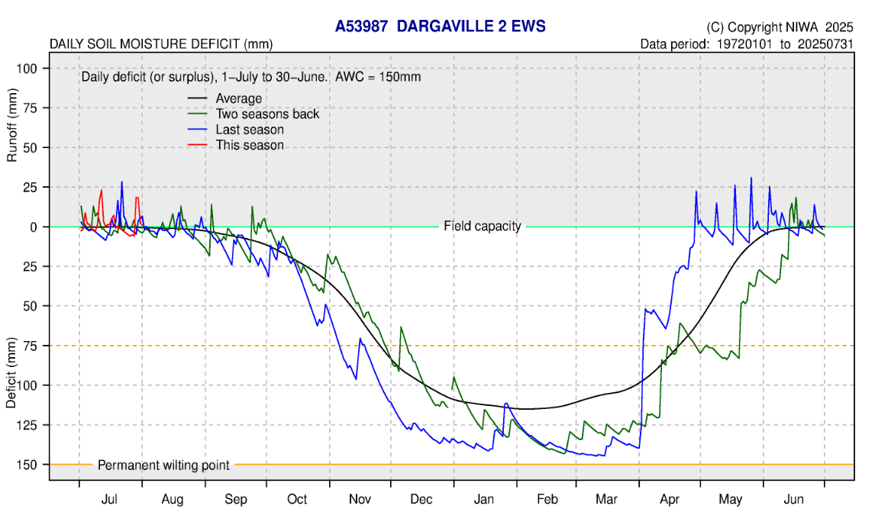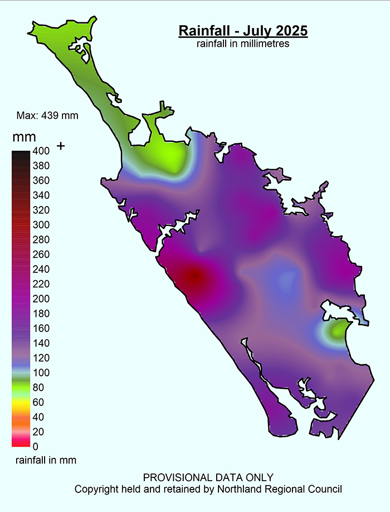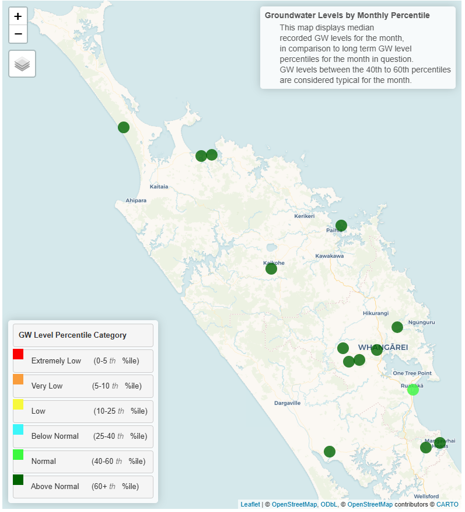July 2025 climate report
21 Aug 2025, 2:00 PM
Key take away from this report
July Rainfall was above average for the region, it’s been a wet start to winter, river flows, ground water levels are high, and soil moisture is at capacity.
Summary
- Northland region averaged 183% of the expected rainfall for July, however there was large variation across the region with ranges from 74% to 237%.
- River flows and groundwater levels were generally above average for July.
- Soil moisture levels are at field capacity and likely to stay that way through August.
- Over the next three months, August to October, temperatures and rainfall are expected to be higher than normal, while river flows are likely to be near normal and chances of heavy rainfall events remain elevated.
Rainfall
Unsettled weather dominated the month of July with several heavy rainfall events occurring due to unusually large blocking highs and fronts coming down from the tropics. There was a brief reprieve in the middle of the month with calm and cool days.
Most rainfall came through from the East, and most of the region received over 150mm of rainfall for the month (figure 1). The maximum rainfall was recorded at Waitangi at Wiroa Road with 439 mm, followed by Kaikohe with 438 mm.
Some of the lowest rainfall recorded was Cape Reinga with 104.5mm and Kai Iwi Lakes with 123mm. The region on average recorded 257 mm which is 183% of the expected rainfall in July (figure 2). The lowest percentage of rainfall was Cape Reinga which recorded 74% of expected and Kai Iwi Lakes which recorded 92%.
The Maximum percentages were recorded in the Mid North with 247% in Kaikohe, and in the Purerua Peninsula with 212% of the expected July totals.
Figure 1 and 2: July 2025 rainfall distribution for Northland in mm, and in percentage of median. Showing an average of 257 mm (183% of expected) rainfall for the region.
On a longer time scale the standardised precipitation index, over three months (Figure 3) shows that the region has been “Normal”. There were outliers in the Mid Northwestern areas, that were wetter than “Normal” and areas around Doubtless Bay drier than normal between May – July. Over six-months the region has been wetter than “Normal” for most of Northland, with a wet end of Autumn and start to Winter between February and July.
Figure 3 and 4: Standardised rainfall for Northland on a 3-month scale (May – July 2025) and a 6-month scale (February – July 2025).
River Flows
River flows in July “Above Normal” to “Normal” across the region (Figure 5). Rivers have some capacity but with soils at field capacity, heavy rainfall events are likely to result in more flooding.
Figure 5: River flows in Northland for July 2025.
Groundwater
Groundwater levels in all key aquifers are high due to a wet start to winter (figure 6). The only outlier is in Ruakākā which is at normal levels. Continued rainfall will keep groundwater levels elevated.
Figure 6: Groundwater levels in Northland’s primary monitored aquifers for July 2025.
Soil moisture
Summary of modelled soil moisture data from NIWA
Soil moisture has been at capacity during July due to several heavy rainfall events. Runoff has increased during the month (figure 7). The soil moisture deficit is calculated based on incoming daily rainfall (mm), outgoing daily potential evapotranspiration (mm), and a fixed available water capacity (the amount of water in the soil 'reservoir' that plants can use) of 150 mm”.
Figure 7: Calculated daily soil moisture values at key areas around Northland, courtesy of NIWA.
 Figure 7: Kaikohe calculated daily soil moisture values – July 2025
Figure 7: Kaikohe calculated daily soil moisture values – July 2025
 Figure 7: Kaitaia calculated daily soil moisture values – July 2025
Figure 7: Kaitaia calculated daily soil moisture values – July 2025
 Figure 7: Kerikeri calculated daily soil moisture values – July 2025
Figure 7: Kerikeri calculated daily soil moisture values – July 2025
 Figure 7: Warkworth calculated daily soil moisture values – July 2025
Figure 7: Warkworth calculated daily soil moisture values – July 2025
 Figure 7: Whangārei calculated daily soil moisture values – July 2025
Figure 7: Whangārei calculated daily soil moisture values – July 2025

Climate Outlook for August – October 2025
Summary of climate forecasts from NIWA
Neutral ENSO (El Niño Southern Oscillation) conditions remain present in the tropical Pacific but have been trending towards La Niña-like conditions in July 2025. This translates into Easterly, North Easterly winds and warmer than normal sea temperatures. The impact for Northland will be temperatures are very likely to be above average (60% chance). Rainfall totals are most likely to be above normal (50% chance) for August – October 2025 as a whole, and chances for heavy rainfall events remain elevated. Soil moisture levels and river flows are most likely to be near normal (45-50% chance).
NIWA’s full outlook can be found at: Seasonal Climate Outlook (NIWA)
Table 1: Forecasted likelihood of above, near or below average climate conditions for Northland from August – October 2025.
(Expressed as % likelihood).
| Temperature | Rainfall | Soil moisture | River flows | |
| Above average | 60 | 50 | 25 | 35 |
| Near average | 30 | 35 | 50 | 45 |
| Below average | 10 | 15 | 25 | 20 |






